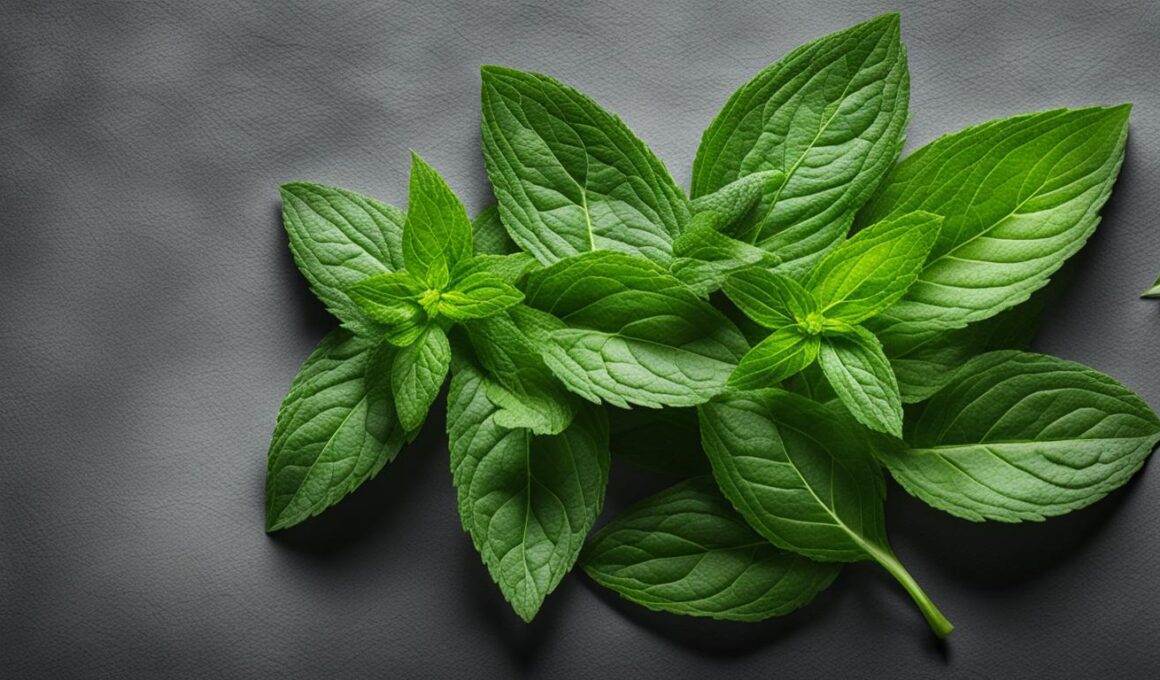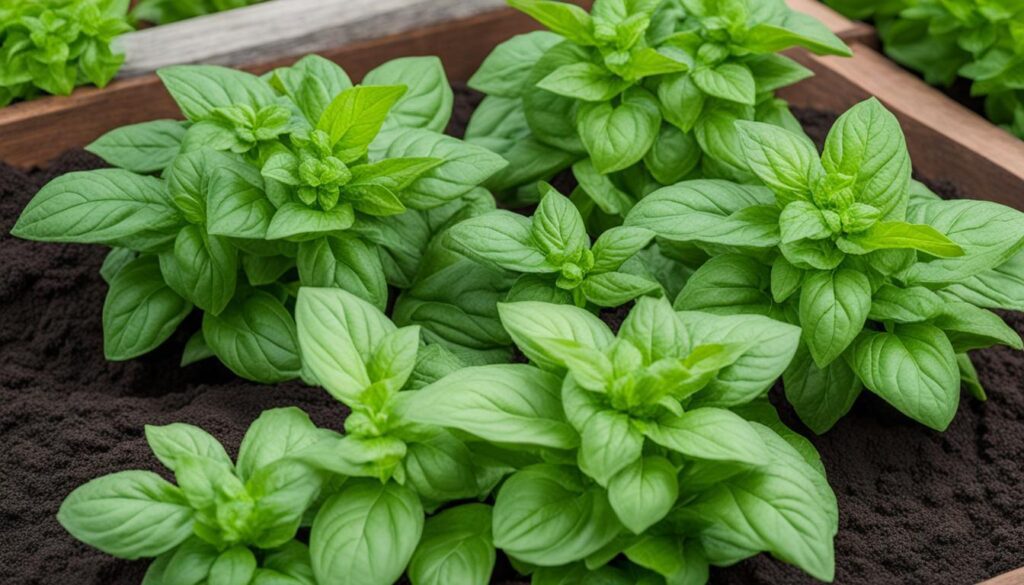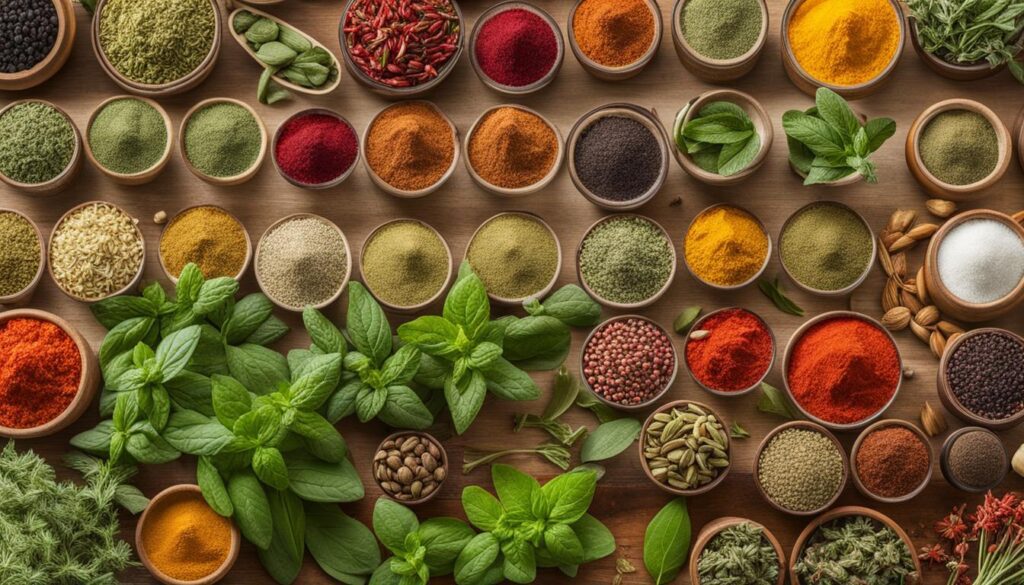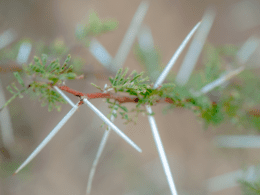Mint and basil are versatile herbs that can enhance the flavor of various dishes. While they have distinct taste profiles, they can be combined to create a unique and delicious flavor combination. Whether you’re a culinary enthusiast or just looking to experiment in the kitchen, exploring the pairing of mint and basil opens up a world of exciting flavor possibilities.
Key Takeaways:
- Both mint and basil can be used together to create a vibrant and aromatic flavor combination.
- Mint has a refreshing and bright taste, while basil adds a savory and aromatic element.
- Pair mint and basil with other ingredients like tomatoes, garlic, fruits, and spices to create diverse flavor profiles.
- Basil and mint offer various health benefits, including anti-inflammatory properties and aiding in digestion.
- Proper storage of fresh basil and mint ensures maximum freshness and shelf life.
The Flavor of Basil and Mint
Basil and mint are both herbs that offer distinct flavor profiles, adding depth and complexity to a wide range of dishes. Understanding the taste characteristics of these herbs can help you create delicious flavor combinations in your cooking.
Basil’s Flavor Profile
Basil has a sweet and slightly peppery taste with hints of pepper and mint. Its flavor is often described as fresh and aromatic, making it a popular choice in Italian and Mediterranean cuisines. Common dishes that showcase basil’s flavor include Caprese salad, pasta sauces, and pesto. The herb’s natural sweetness pairs well with ingredients like tomatoes, garlic, lemon, pine nuts, and Parmesan cheese, creating a harmonious blend of flavors.
Mint’s Flavor Profile
Mint has a refreshing and cooling flavor with a slightly sweet and bright taste. It is commonly used in drinks, desserts, and Middle Eastern and Asian cuisines. Mint’s flavor profile complements fruits like watermelon, berries, citrus, and tropical fruits, as well as spices like cinnamon, ginger, and cardamom. The herb’s cooling properties and refreshing taste make it an ideal ingredient for refreshing beverages and soothing desserts.
| Basil | Mint | |
|---|---|---|
| Taste | Sweet with hints of pepper and mint | Refreshing and bright with a slight sweetness |
| Cuisine | Italian and Mediterranean | Middle Eastern and Asian |
| Common Pairings | Tomatoes, garlic, lemon, pine nuts, Parmesan cheese | Watermelon, berries, citrus, tropical fruits, cinnamon, ginger, cardamom |
Mint’s refreshing flavor adds a cooling and invigorating element to any dish, while basil’s aromatic sweetness brings depth and complexity. When combined, these herbs create a unique balance of flavors that can take your culinary creations to the next level.
Experiment with using basil and mint together in different recipes to explore the exciting flavor possibilities. Whether you’re preparing a refreshing summer drink, a vibrant salad, or a comforting pasta dish, the combination of basil and mint is sure to tantalize your taste buds and add a touch of culinary creativity to your meals.
Pairing Basil and Mint with Other Ingredients
Basil and mint can be paired with a variety of ingredients to create exciting and flavorful dishes. Whether you’re looking to add a refreshing element or a burst of aromatic flavors, these herbs can elevate your culinary creations. Here are some recommended flavor pairings:
- Basil and tomatoes: This classic combination is a staple in Italian cuisine. The sweetness of ripe tomatoes complements the herbaceous notes of basil, resulting in a harmonious and vibrant flavor.
- Mint and watermelon: The cool and refreshing taste of mint pairs perfectly with the juicy and sweet flavors of watermelon. This combination is perfect for summer salads, beverages, or even chilled soups.
- Basil and garlic: When combined, basil’s subtle sweetness and garlic’s pungent aroma create a dynamic duo. This pairing is commonly used in pasta sauces, stir-fries, and marinades.
- Mint and citrus: The bright and zesty flavors of citrus fruits like lemon, lime, and orange complement the refreshing taste of mint. This combination is ideal for cocktails, salads, and desserts.
- Basil and pine nuts: The creamy and nutty flavor of pine nuts adds richness to the herbaceous taste of basil. This pairing is commonly used in pesto sauce, adding depth and flavor to pasta, sandwiches, and more.
These are just a few examples of the countless flavor pairings you can explore with basil and mint. Don’t be afraid to experiment and get creative in your kitchen. The versatility of these herbs allows you to create unique and exciting dishes that will impress your family and friends.
“The combination of basil and tomatoes is a classic pairing that never fails to deliver a burst of flavor.”
Remember to use fresh, high-quality ingredients to enhance the taste of your dishes. Whether you’re making a refreshing summer salad or a comforting pasta dish, the combination of basil and mint with other ingredients will add depth and complexity to your meals.
| Ingredient | Pairing |
|---|---|
| Tomatoes | Basil |
| Watermelon | Mint |
| Garlic | Basil |
| Citrus fruits | Mint |
| Pine nuts | Basil |
Table: Recommended flavor pairings for basil and mint
Health Benefits and Storage Tips
When it comes to basil and mint, these versatile herbs not only add delicious flavors to your dishes but also offer various health benefits. Basil contains essential vitamins and minerals, antioxidants, and essential oils that can help reduce inflammation, improve digestion, and support overall health. It is a great source of vitamin K, which promotes healthy blood clotting and bone health. Additionally, basil is rich in antioxidants, such as flavonoids and phenolic compounds, which have been shown to have anti-inflammatory and antimicrobial properties.
Mint, on the other hand, is well-known for its calming and soothing properties. It is commonly used to aid in digestion, relieve indigestion or nausea, and promote overall gastrointestinal health. Mint also contains menthol, a compound that creates a cooling sensation and can help alleviate headaches and sinus congestion. Furthermore, mint is rich in antioxidants, vitamins, and minerals, making it a nutritious addition to your diet.
Storage Tips
Proper storage is essential to maintain the freshness of your basil and mint. Fresh basil should be stored in the refrigerator to prolong its shelf life. To keep it fresh for longer, place the basil stems in a glass of water, similar to how you would store fresh flowers. Alternatively, you can wrap the basil leaves in a damp paper towel and store them in a plastic bag in the refrigerator. This method helps retain moisture and prevents wilting.
For mint, you can store it in a similar manner. Gently wash the mint leaves, pat them dry, and then loosely wrap them in a slightly damp paper towel. Place the wrapped leaves in a plastic bag or airtight container and store them in the refrigerator. This method helps preserve the vibrant green color and refreshing flavor of the mint leaves.
| Herb | Storage Method | Shelf Life |
|---|---|---|
| Basil | Refrigerator with stems in water or wrapped in a damp paper towel | Up to 1 week |
| Mint | Refrigerator with leaves wrapped in a slightly damp paper towel | Up to 1 week |
| Dried Basil | Airtight container in a cool, dark place | Up to 3 years |
| Dried Mint | Airtight container in a cool, dark place | Up to 3 years |
By following these storage tips, you can ensure that your basil and mint stay fresh and flavorful for longer, allowing you to enjoy their health benefits and enhance the taste of your culinary creations.
Are Mint and Basil Complementary Flavors in Cooking?
Mint and basil are often used together in cooking to add a refreshing and aromatic twist to dishes. The combination of their flavors creates a balanced and complementary taste. When looking to enhance your recipes, consider planting these best herbs for basil planting side by side for easy access in your kitchen garden.
Conclusion
In conclusion, basil and mint are versatile herbs that can be used individually or together to create a range of delicious flavor combinations. The combination of sweet basil and refreshing mint can add complexity and depth to various dishes, from pesto to pasta sauces to appetizers and flatbread pizzas. Both herbs have their own distinct flavors and health benefits, making them valuable additions to any kitchen.
Whether you’re a fan of Italian cuisine or looking to explore new flavor pairings, basil and mint are a dynamic duo that should not be overlooked. The versatility of these herbs allows you to experiment and unlock a world of new and exciting flavors in your cooking. Don’t be afraid to get creative and try different combinations to find your favorite basil and mint flavor profiles.
So next time you’re in the kitchen, grab some fresh basil and mint, and let your culinary imagination run wild. With their incredible flavors and endless possibilities, these versatile herbs are sure to elevate your dishes and impress your taste buds. Enjoy the exploration of flavor combinations with basil and mint, and savor the delicious results!
FAQ
Can I combine mint and basil in recipes?
Yes, mint and basil can be combined to create unique and delicious flavor combinations.
What are some ways to use mint and basil together?
Mint and basil can be used in pesto, pasta dishes, flatbread pizzas, and appetizers.
What flavors do basil and mint have?
Basil has a sweet and slightly peppery taste, while mint has a refreshing and cooling flavor.
What are some suggested flavor pairings for basil and mint?
Basil pairs well with tomatoes, garlic, lemon, pine nuts, and Parmesan cheese. Mint pairs well with fruits like watermelon, berries, citrus, and spices like cinnamon, ginger, and cardamom.
What are the health benefits of basil and mint?
Basil contains vitamins, minerals, antioxidants, and essential oils that help reduce inflammation and improve digestion. Mint is known for its calming properties, aids in digestion, and provides relief from indigestion or nausea.
How should I store fresh basil and mint?
Fresh basil should be stored in the refrigerator with the stems in water or wrapped in a damp paper towel. Mint can be stored similarly, with the leaves loosely wrapped in a slightly damp paper towel.
How long can dried basil and mint be stored?
Dried basil can be stored in an airtight container in a cool, dark place for up to three years. Dried mint should be stored similarly for optimal shelf life.










